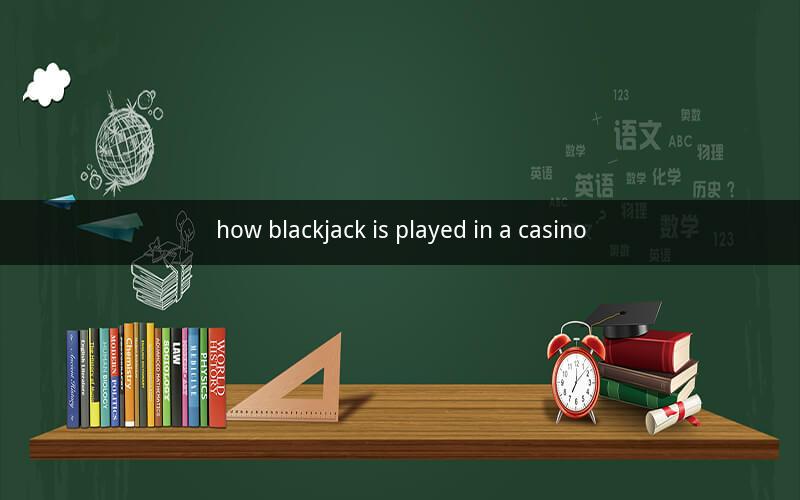
Table of Contents
1. Introduction to Blackjack
2. The Objective of Blackjack
3. The Blackjack Table
4. The Card Values
5. The Basics of the Game
6. The Dealer's Role
7. Player Actions
8. The Dealer's Play
9. Winning and Losing
10. Strategy and Tips
11. Conclusion
1. Introduction to Blackjack
Blackjack is a popular card game that combines skill, strategy, and a touch of luck. It is widely played in casinos around the world and has become a staple in the gaming industry. Understanding how blackjack is played in a casino can enhance your experience and potentially improve your chances of winning.
2. The Objective of Blackjack
The objective of blackjack is to have a hand with a higher total value than the dealer's hand without exceeding 21. The hand with the closest total to 21 without going over wins the round.
3. The Blackjack Table
Blackjack tables are typically round or oval, with a felt surface. The table is equipped with several seats for players and a dealer's station. The layout of the table includes betting areas, card decks, and markers for each player's hand.
4. The Card Values
In blackjack, face cards (Jack, Queen, and King) are valued at 10, and Aces can be either 1 or 11, depending on the player's choice. Number cards are valued at their face value, with 2 through 10 retaining their respective numbers.
5. The Basics of the Game
Players start by placing bets on the table. Once the bets are in, the dealer gives each player two cards, one face-up and one face-down. The dealer also receives two cards, but one is face-down and one is face-up. This face-down card is known as the dealer's hole card.
6. The Dealer's Role
The dealer is responsible for shuffling the cards, dealing the cards to players, and ensuring that the game is played according to the rules. The dealer also has the final say on the outcome of each hand.
7. Player Actions
After receiving their cards, players have several options:
- Hit: Ask for another card.
- Stand: Keep the current hand and no longer take any cards.
- Split: If the player has two identical cards, they can split them into two separate hands and play them independently.
- Double Down: Double the original bet and receive one additional card. After this, the player must stand.
- Surrender: Choose to give up the hand and forfeit half of the original bet.
8. The Dealer's Play
The dealer follows a set of rules when playing their hand. They must hit until their hand has a total of 17 or higher, and they must stand on a soft 17 (an Ace and a 6 or 7). If the dealer's hand exceeds 21, it is considered a "bust," and all players who have not busted win.
9. Winning and Losing
Players win if their hand is closer to 21 than the dealer's hand without going over. If both the player and the dealer bust, the dealer wins. If both have the same total, it is a "push," and players receive their bets back.
10. Strategy and Tips
- Always play basic strategy to maximize your chances of winning.
- Avoid insurance bets, as they have a high house edge.
- Keep track of the dealer's up card to make informed decisions.
- Practice proper money management to avoid losing too much money.
Conclusion
Blackjack is a game of skill and strategy that requires players to understand the rules, card values, and the dealer's role. By following these guidelines and practicing good strategy, players can increase their chances of winning at the blackjack table.
Questions and Answers
1. What is the objective of blackjack?
- The objective of blackjack is to have a hand with a higher total value than the dealer's hand without exceeding 21.
2. What are the values of the cards in blackjack?
- Face cards (Jack, Queen, and King) are valued at 10, and Aces can be either 1 or 11.
3. What are the basic player actions in blackjack?
- Players can hit, stand, split, double down, or surrender.
4. What is the dealer's role in blackjack?
- The dealer is responsible for shuffling the cards, dealing the cards to players, and ensuring that the game is played according to the rules.
5. How does the dealer play their hand?
- The dealer must hit until their hand has a total of 17 or higher and must stand on a soft 17.
6. What happens if both the player and the dealer bust?
- If both the player and the dealer bust, the dealer wins.
7. What is the house edge in blackjack?
- The house edge in blackjack can vary depending on the rules of the game and the player's strategy.
8. Why should players avoid insurance bets?
- Insurance bets have a high house edge and are generally considered a bad bet.
9. How can players practice good money management in blackjack?
- Players can practice good money management by setting a budget, sticking to it, and avoiding chasing losses.
10. What is the best strategy for playing blackjack?
- The best strategy for playing blackjack is to follow basic strategy, which is a set of guidelines that tells players the best action to take in any given situation.